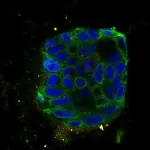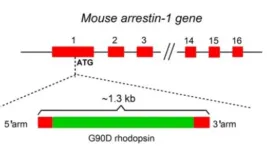(Press-News.org) Using tools, like shells and rocks, to open their often thick-shelled mollusk prey increases foraging success in sea otters and protects their teeth from damage by allowing the animals to eat prey that would otherwise be difficult to obtain. The findings suggest that this behavior is a necessity for the survival of some otters in environments where competition is high and preferred prey is in short supply. Sea otters are well-known tool users. Aside from crushing prey with their teeth, sea otters have been observed using rocks, shells, human litter, and even the hulls of boats to bash open hard prey, including marine snails, sea urchins, or clams. In general, sea otters prefer to forage on prey that are not only rich in energy but also easy to process. However, in areas where the animal occurs at high densities, intraspecific competition can lead to easy-to-access prey becoming depleted, driving some otters to specialize on alternative pretty types, which influences their reliance on tool use for foraging. Using longitudinal data from 196 radio-tagged sea otters, Chris Law and colleagues investigated whether tool use enhances the foraging success of individual southern sea otters (Enhydra lutris nereis) by allowing them to increase the diversity of harder-shelled prey and increases fitness by preventing dental injury. In general, Law et al. found that tool-use frequency enabled the use of a wider variety of prey, which led to higher energy consumption rates and reduced tooth wear. However, this pattern was not linear – some infrequent tool users had more damaged teeth than otters that did not use tools at all, likely due to diet specialization. Individuals that prefer prey where tools are needed tend to use tools to access all prey types. In contrast, those that prefer prey that can be accessed without tools risk damaging their teeth – and, by extension, reducing their overall fitness – because they tend to not use tools unless absolutely necessary. Unique to female otters, the more an animal relied on tool use, the more often it processed harder prey, increasing the foraging success of female otters, suggesting that tool-using behavior is disproportionally more beneficial for females, perhaps by enabling them to overcome the physical constraints of processing harder prey given their smaller body size and weaker biting strength. In a related Perspective, Barbara Klump discusses the study in greater detail.
END
Tool use promotes foraging success and dental health in sea otters
2024-05-16
ELSE PRESS RELEASES FROM THIS DATE:
Advances in priming B cell immunity against HIV pave the way to future HIV vaccines, shows quartet of new studies
2024-05-16
Scientists have made several advances in the design of a class of HIV vaccines that could offer broad protection against the virus, according to four new research papers published this week in Science, Science Translational Medicine, and Science Immunology. “The studies […] exemplify progress in the rational design of [germline-targeting] HIV-1 vaccines, and what is being learned will guide [germline-targeting] programs for inducing [broadly neutralizing antibodies] against other human pathogens,” Rogier Sanders and John Moore write in a related ...
Total energy cost of animal reproduction is higher than previously assumed
2024-05-16
The energy invested in animal reproduction is as much as 10 times greater than previously estimated when the metabolic load of bearing and caring for offspring is accounted for, according to a new study. The findings fundamentally challenge longstanding theories and biological models of animal growth and life histories. The act of reproduction is one of the largest energy investments an animal can make. This investment includes direct cost, the energy directly invested in the offspring themselves, and indirect costs, the energy expended to create, carry, and care for offspring before they are born. While the direct costs of reproduction are well understood, the indirect ...
Researchers discover new pathway to cancer cell suicide
2024-05-16
Researchers discover new pathway to cancer cell suicide
Chemotherapy kills cancer cells. But the way these cells die appears to be different than previously understood. Researchers from the Netherlands Cancer Institute, led by Thijn Brummelkamp, have uncovered a completely new way in which cancer cells die: due to the Schlafen11 gene. "This is a very unexpected finding. Cancer patients have been treated with chemotherapy for almost a century, but this route to cell death has never been observed before. Where and when this occurs in patients will need to be further investigated. This discovery could ultimately have implications for the treatment of cancer patients." They publish their ...
Researchers wrestle with accuracy of AI technology used to create new drug candidates
2024-05-16
CHAPEL HILL, N.C. – Artificial intelligence (AI) has numerous applications in healthcare, from analyzing medical imaging to optimizing the execution of clinical trials, and even facilitating drug discovery.
AlphaFold2, an artificial intelligence system that predicts protein structures, has made it possible for scientists to identify and conjure an almost infinite number of drug candidates for the treatment of neuropsychiatric disorders. However recent studies have sown doubt about the accuracy of AlphaFold2 in modeling ligand binding sites, the areas on proteins where drugs attach and begin signaling ...
Breaking bonds to form bonds: Rethinking the Chemistry of Cations
2024-05-16
A team of chemists from the University of Vienna, led by Nuno Maulide, has achieved a significant breakthrough in the field of chemical synthesis, developing a novel method for manipulating carbon-hydrogen bonds. This groundbreaking discovery provides new insights into the molecular interactions of positively charged carbon atoms. By selectively targeting a specific C–H bond, they open doors to synthetic pathways that were previously closed – with potential applications in medicine. The study was recently published in the prestigious journal Science.
Living ...
New gene delivery vehicle shows promise for human brain gene therapy
2024-05-16
In an important step toward more effective gene therapies for brain diseases, researchers from the Broad Institute of MIT and Harvard have engineered a gene-delivery vehicle that uses a human protein to efficiently cross the blood-brain barrier and deliver a disease-relevant gene to the brain in mice expressing the human protein. Because the vehicle binds to a well-studied protein in the blood-brain barrier, the scientists say it has a good chance at working in patients.
Gene therapy could potentially treat a range of severe genetic brain disorders, which currently ...
Finding quantum order in chaos
2024-05-16
If you zoom in on a chemical reaction to the quantum level, you’ll notice that particles behave like waves that can ripple and collide. Scientists have long sought to understand quantum coherence, the ability of particles to maintain phase relationships and exist in multiple states simultaneously; this is akin to all parts of a wave being synchronized. It has been an open question whether quantum coherence can persist through a chemical reaction where bonds dynamically break and form.
Now, for the first time, a team of Harvard scientists has demonstrated the survival of quantum coherence in a chemical reaction involving ultracold molecules. These findings highlight the potential of ...
Study suggests high-frequency electrical ‘noise’ results in congenital night blindness
2024-05-16
In what they believe is a solution to a 30-year biological mystery, neuroscientists at Johns Hopkins Medicine say they have used genetically engineered mice to address how one mutation in the gene for the light-sensing protein rhodopsin results in congenital stationary night blindness.
The condition, present from birth, causes poor vision in low-light settings.
The findings, published May 14 in Proceedings of the National Academy of Sciences, demonstrate that the rhodopsin gene mutation, called ...
TeltoHeart wristband, developed by Lithuanians, receives important medical device certification
2024-05-16
Teltonika’s TeltoHeart, a multifunctional smart wristband system developed in cooperation between Lithuanian industry and universities has been given the CE MDR (Class IIa) medical device certification. This approval confirms that the product meets the comprehensive quality standards for medical devices and opens up new markets worldwide for this innovative product.
"This is an important recognition that we have been working towards since the start of this project in 2020. The CE MDR certification proves that TeltoHeart is a safe ...
Unique brain circuit is linked to Body Mass Index
2024-05-16
· One region is related to olfaction and reward, the other to negative feelings like pain · When the connection between these brain regions is weak, people have higher BMI
· Food may continue to be rewarding, even when these individuals are full
CHICAGO --- Why can some people easily stop eating when they are full and others can’t, which can lead to obesity?
A Northwestern Medicine study has found one reason may be a newly discovered structural connection ...




